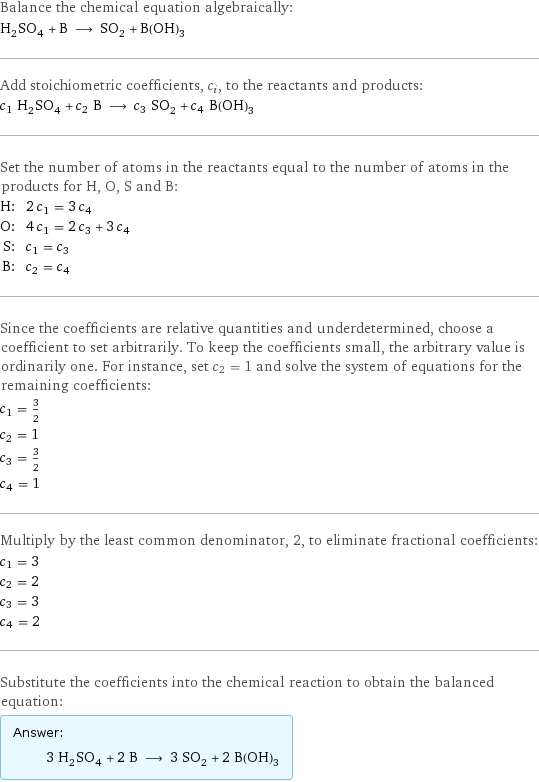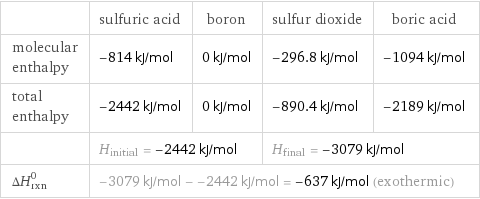Input interpretation

H_2SO_4 sulfuric acid + B boron ⟶ SO_2 sulfur dioxide + B(OH)_3 boric acid
Balanced equation

Balance the chemical equation algebraically: H_2SO_4 + B ⟶ SO_2 + B(OH)_3 Add stoichiometric coefficients, c_i, to the reactants and products: c_1 H_2SO_4 + c_2 B ⟶ c_3 SO_2 + c_4 B(OH)_3 Set the number of atoms in the reactants equal to the number of atoms in the products for H, O, S and B: H: | 2 c_1 = 3 c_4 O: | 4 c_1 = 2 c_3 + 3 c_4 S: | c_1 = c_3 B: | c_2 = c_4 Since the coefficients are relative quantities and underdetermined, choose a coefficient to set arbitrarily. To keep the coefficients small, the arbitrary value is ordinarily one. For instance, set c_2 = 1 and solve the system of equations for the remaining coefficients: c_1 = 3/2 c_2 = 1 c_3 = 3/2 c_4 = 1 Multiply by the least common denominator, 2, to eliminate fractional coefficients: c_1 = 3 c_2 = 2 c_3 = 3 c_4 = 2 Substitute the coefficients into the chemical reaction to obtain the balanced equation: Answer: | | 3 H_2SO_4 + 2 B ⟶ 3 SO_2 + 2 B(OH)_3
Structures

+ ⟶ +
Names

sulfuric acid + boron ⟶ sulfur dioxide + boric acid
Reaction thermodynamics
Enthalpy

| sulfuric acid | boron | sulfur dioxide | boric acid molecular enthalpy | -814 kJ/mol | 0 kJ/mol | -296.8 kJ/mol | -1094 kJ/mol total enthalpy | -2442 kJ/mol | 0 kJ/mol | -890.4 kJ/mol | -2189 kJ/mol | H_initial = -2442 kJ/mol | | H_final = -3079 kJ/mol | ΔH_rxn^0 | -3079 kJ/mol - -2442 kJ/mol = -637 kJ/mol (exothermic) | | |
Equilibrium constant
![Construct the equilibrium constant, K, expression for: H_2SO_4 + B ⟶ SO_2 + B(OH)_3 Plan: • Balance the chemical equation. • Determine the stoichiometric numbers. • Assemble the activity expression for each chemical species. • Use the activity expressions to build the equilibrium constant expression. Write the balanced chemical equation: 3 H_2SO_4 + 2 B ⟶ 3 SO_2 + 2 B(OH)_3 Assign stoichiometric numbers, ν_i, using the stoichiometric coefficients, c_i, from the balanced chemical equation in the following manner: ν_i = -c_i for reactants and ν_i = c_i for products: chemical species | c_i | ν_i H_2SO_4 | 3 | -3 B | 2 | -2 SO_2 | 3 | 3 B(OH)_3 | 2 | 2 Assemble the activity expressions accounting for the state of matter and ν_i: chemical species | c_i | ν_i | activity expression H_2SO_4 | 3 | -3 | ([H2SO4])^(-3) B | 2 | -2 | ([B])^(-2) SO_2 | 3 | 3 | ([SO2])^3 B(OH)_3 | 2 | 2 | ([B(OH)3])^2 The equilibrium constant symbol in the concentration basis is: K_c Mulitply the activity expressions to arrive at the K_c expression: Answer: | | K_c = ([H2SO4])^(-3) ([B])^(-2) ([SO2])^3 ([B(OH)3])^2 = (([SO2])^3 ([B(OH)3])^2)/(([H2SO4])^3 ([B])^2)](../image_source/41228a937158e273b115e4a58feef3bf.png)
Construct the equilibrium constant, K, expression for: H_2SO_4 + B ⟶ SO_2 + B(OH)_3 Plan: • Balance the chemical equation. • Determine the stoichiometric numbers. • Assemble the activity expression for each chemical species. • Use the activity expressions to build the equilibrium constant expression. Write the balanced chemical equation: 3 H_2SO_4 + 2 B ⟶ 3 SO_2 + 2 B(OH)_3 Assign stoichiometric numbers, ν_i, using the stoichiometric coefficients, c_i, from the balanced chemical equation in the following manner: ν_i = -c_i for reactants and ν_i = c_i for products: chemical species | c_i | ν_i H_2SO_4 | 3 | -3 B | 2 | -2 SO_2 | 3 | 3 B(OH)_3 | 2 | 2 Assemble the activity expressions accounting for the state of matter and ν_i: chemical species | c_i | ν_i | activity expression H_2SO_4 | 3 | -3 | ([H2SO4])^(-3) B | 2 | -2 | ([B])^(-2) SO_2 | 3 | 3 | ([SO2])^3 B(OH)_3 | 2 | 2 | ([B(OH)3])^2 The equilibrium constant symbol in the concentration basis is: K_c Mulitply the activity expressions to arrive at the K_c expression: Answer: | | K_c = ([H2SO4])^(-3) ([B])^(-2) ([SO2])^3 ([B(OH)3])^2 = (([SO2])^3 ([B(OH)3])^2)/(([H2SO4])^3 ([B])^2)
Rate of reaction
![Construct the rate of reaction expression for: H_2SO_4 + B ⟶ SO_2 + B(OH)_3 Plan: • Balance the chemical equation. • Determine the stoichiometric numbers. • Assemble the rate term for each chemical species. • Write the rate of reaction expression. Write the balanced chemical equation: 3 H_2SO_4 + 2 B ⟶ 3 SO_2 + 2 B(OH)_3 Assign stoichiometric numbers, ν_i, using the stoichiometric coefficients, c_i, from the balanced chemical equation in the following manner: ν_i = -c_i for reactants and ν_i = c_i for products: chemical species | c_i | ν_i H_2SO_4 | 3 | -3 B | 2 | -2 SO_2 | 3 | 3 B(OH)_3 | 2 | 2 The rate term for each chemical species, B_i, is 1/ν_i(Δ[B_i])/(Δt) where [B_i] is the amount concentration and t is time: chemical species | c_i | ν_i | rate term H_2SO_4 | 3 | -3 | -1/3 (Δ[H2SO4])/(Δt) B | 2 | -2 | -1/2 (Δ[B])/(Δt) SO_2 | 3 | 3 | 1/3 (Δ[SO2])/(Δt) B(OH)_3 | 2 | 2 | 1/2 (Δ[B(OH)3])/(Δt) (for infinitesimal rate of change, replace Δ with d) Set the rate terms equal to each other to arrive at the rate expression: Answer: | | rate = -1/3 (Δ[H2SO4])/(Δt) = -1/2 (Δ[B])/(Δt) = 1/3 (Δ[SO2])/(Δt) = 1/2 (Δ[B(OH)3])/(Δt) (assuming constant volume and no accumulation of intermediates or side products)](../image_source/1554dae6f346fda3e30cf1df5500a1cc.png)
Construct the rate of reaction expression for: H_2SO_4 + B ⟶ SO_2 + B(OH)_3 Plan: • Balance the chemical equation. • Determine the stoichiometric numbers. • Assemble the rate term for each chemical species. • Write the rate of reaction expression. Write the balanced chemical equation: 3 H_2SO_4 + 2 B ⟶ 3 SO_2 + 2 B(OH)_3 Assign stoichiometric numbers, ν_i, using the stoichiometric coefficients, c_i, from the balanced chemical equation in the following manner: ν_i = -c_i for reactants and ν_i = c_i for products: chemical species | c_i | ν_i H_2SO_4 | 3 | -3 B | 2 | -2 SO_2 | 3 | 3 B(OH)_3 | 2 | 2 The rate term for each chemical species, B_i, is 1/ν_i(Δ[B_i])/(Δt) where [B_i] is the amount concentration and t is time: chemical species | c_i | ν_i | rate term H_2SO_4 | 3 | -3 | -1/3 (Δ[H2SO4])/(Δt) B | 2 | -2 | -1/2 (Δ[B])/(Δt) SO_2 | 3 | 3 | 1/3 (Δ[SO2])/(Δt) B(OH)_3 | 2 | 2 | 1/2 (Δ[B(OH)3])/(Δt) (for infinitesimal rate of change, replace Δ with d) Set the rate terms equal to each other to arrive at the rate expression: Answer: | | rate = -1/3 (Δ[H2SO4])/(Δt) = -1/2 (Δ[B])/(Δt) = 1/3 (Δ[SO2])/(Δt) = 1/2 (Δ[B(OH)3])/(Δt) (assuming constant volume and no accumulation of intermediates or side products)
Chemical names and formulas

| sulfuric acid | boron | sulfur dioxide | boric acid formula | H_2SO_4 | B | SO_2 | B(OH)_3 Hill formula | H_2O_4S | B | O_2S | BH_3O_3 name | sulfuric acid | boron | sulfur dioxide | boric acid
Substance properties

| sulfuric acid | boron | sulfur dioxide | boric acid molar mass | 98.07 g/mol | 10.81 g/mol | 64.06 g/mol | 61.83 g/mol phase | liquid (at STP) | solid (at STP) | gas (at STP) | solid (at STP) melting point | 10.371 °C | 2075 °C | -73 °C | 160 °C boiling point | 279.6 °C | 4000 °C | -10 °C | density | 1.8305 g/cm^3 | 2.34 g/cm^3 | 0.002619 g/cm^3 (at 25 °C) | solubility in water | very soluble | insoluble | | surface tension | 0.0735 N/m | | 0.02859 N/m | dynamic viscosity | 0.021 Pa s (at 25 °C) | | 1.282×10^-5 Pa s (at 25 °C) | odor | odorless | | | odorless
Units
